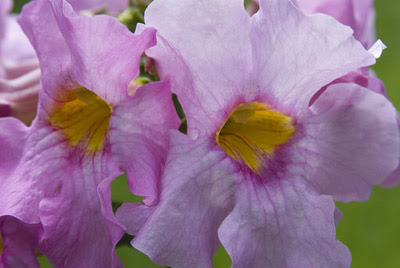There is a bank (I love it well)
Where climbs the sorrel of the wood,
Here breathes, how frail! a puce-veined bell,
There snowy droops its crumpled hood.
With knotted roots of tinctured strings
A tender tapestry it weaves,
Whilst folding back like soft green wings
The lappets of its cloven leaves.
It is a dainty sight, I ween,
Of hoods, and bells, and fairy green ;
But when the dews of evening fall,
They mutely bless the Lord of all,
And, closing, wait the daylight's call!
Hard by, o'ershadowed by the forest trees,
Like partial snowshowers, wood anemones
Outstretched in level masses of white shade
People with magic companies the glade,
As fairy-land borne flying on the breeze
Had lighted round gnarled oaks of centuries,
While Spring repairs her roofless palaces.
- Rev. Charles Armstrong Fox (19th century English pastor, poet, theologian)
The magical charm of wood sorrel captures the imagination even now as it did for Charles Fox, the poet of Keswick. (You have to get down on your knees, close and personal to appreciate things like that.) In addition to poetry, he published a few books of Keswick theology, a controversial view among Protestants, which emphasized a higher level of Christian spirituality. His books included Victories and Safeguards, Ankle Deep, and Conquered and Kept. A very devout man and a leader in the early days of the Keswick Convention, Rev. Fox reveled in nature and blessed its Creator. Certainly, nature's delights are plentiful, so he had a lot to be thankful for.
Fairies and magic are often associated with wood sorrel because of its resemblance to the Irish shamrock. Potted oxalis plants are traditionally given around St. Patrick's Day. But wood sorrel isn't called False Shamrock for nothing, for true shamrock is actually clover (Trifolium repens or T. dubium). Nevertheless, don't let that little bit of knowledge spoil your fun. White clover is nowhere near as appealing as oxalis in a decorative planter or in the garden.
Wood Sorrel (aka False Shamrock) belongs to the genus, Oxalis, and is a member of the Oxalidaceae family. Oxalis consists of about 800 species which are native worldwide. Some are annuals; others are perennials. Indigenous people and little boys around the world have munched on sorrels for food and fun. The leaves may be eaten alone or added to salads. The plants contain oxalic acid, which gives them a sour but refreshing taste.
A childhood friend of mine, who I shall call 'Andy Hitt' to protect his identity, said that wood sorrel and sheep sorrel, both containing oxalates, tasted that way because his dog, Bud, had peed on them. As it turns out, oxalates are eliminated by urine, so now that I think of it he might not have been kidding.
Though oxalic acid can be dangerous in large amounts, oxalicacidinfo.com assures that it's highly unlikely occasionally eating sorrels would have any toxic effect. That's good to know.
One species of False Shamrock, O. acetosella, has been eaten to sustain life during famine. Edmund Spenser, by no means a friend of the Irish, wrote in his View of the State of Ireland during a Famine, "Out of every corner of the wods and glynnis they come creeping forth upon their hands, for their legs could not bear them; they looked like anatomies of death; they spoke like ghosts crying out of their graves; they did eat the dead carrions; and if they found a plot of watercresses or shamrocks, they flocked as to a feast..."
There are several important Oxalis species grown ornamentally: O. adenophylla, O. brasiliensis, O. deppei (syn. O. tetraphylla), O. lasiandra, O. triangularis and O. versicolor.
Hardiness varies by species. Where they are hardy, they are excellent for bulb gardens, perennial gardens and borders, and naturalizing. Plant oxalis tubers 12 inches to 15 inches apart and 1 inch to 1-1/2 inches deep in full sun to partial shade in average, well-drained garden soil with pH ranging from 6.1 to 7.8. Planting depth is measured to the bottom of the hole. Oxalis can be grown in any climate in container gardens, and they may be grown indoors or out.
If planting in the garden, take a sample of your garden soil to your local Cooperative Extension Service office. For a small fee, they will send it to a lab for analysis and return a report to you. Your soil sample report will include recommendations for amending the soil. If planting in containers, use a good grade of sphagnum-based potting soil.
Unless you are naturalizing them in the lawn, prepare the planting bed by cultivating at least 8" deep, removing all traces of weeds. A good practice is to mix 5 tablespoons of 10-10-10 fertilizer and 2 cups of bone meal per ten square feet area of bulb garden. Don't let synthetic fertilizer come into direct contact with plants.
When your False Shamrocks begin to sprout and bloom, you'll agree with Rev. Fox, "It is a dainty sight, I ween, of hoods, and bells, and fairy green."
Return to GoGardenNow.com.














